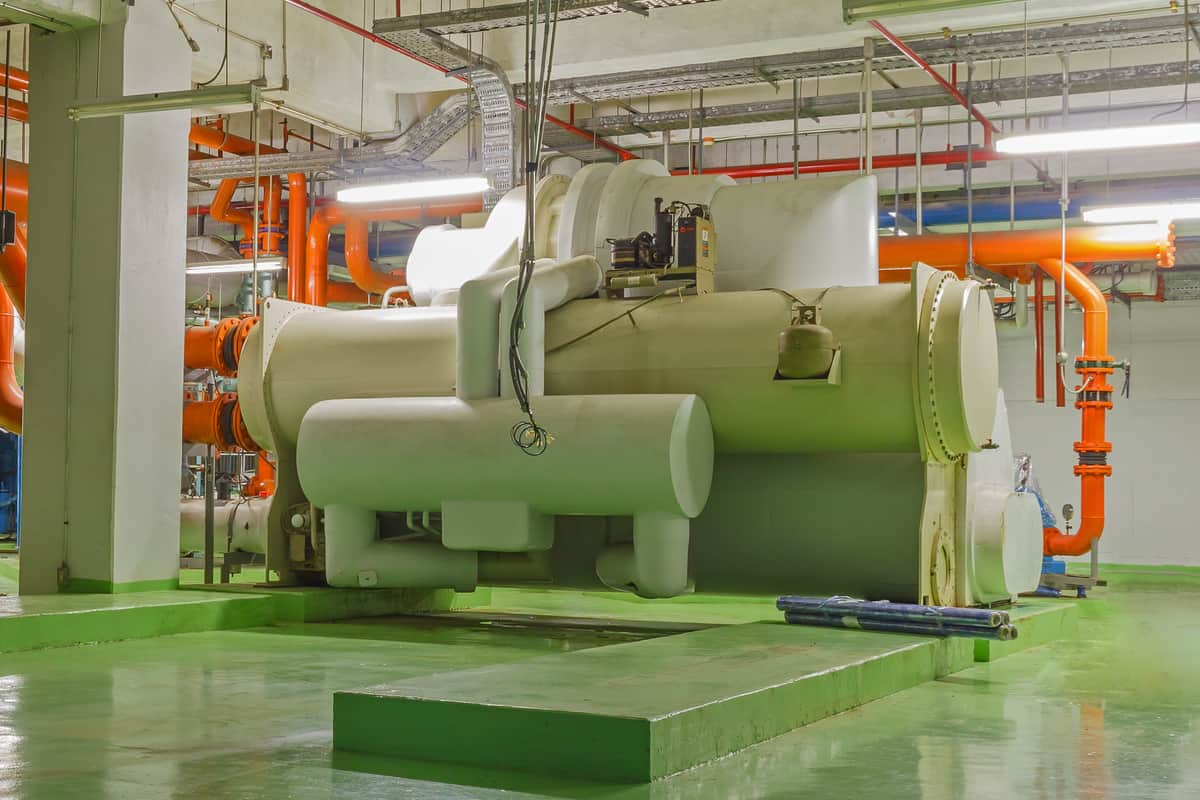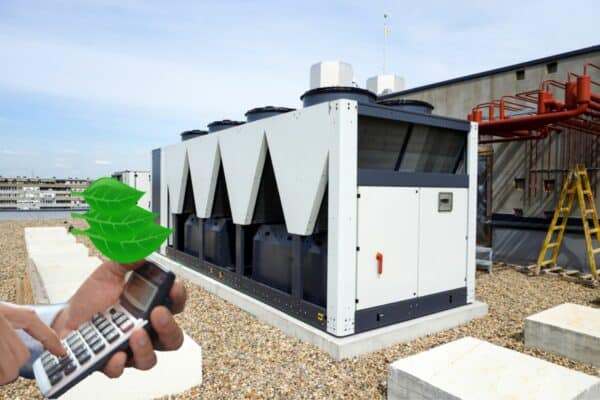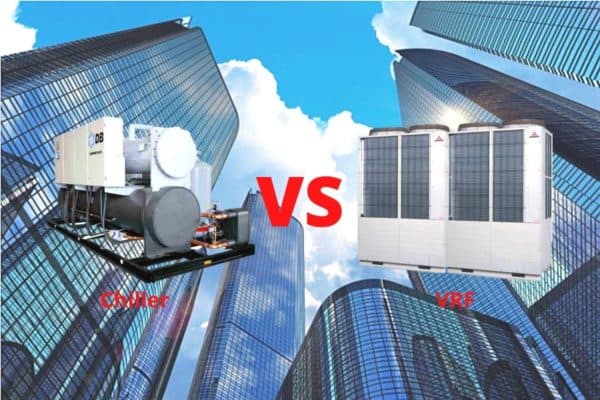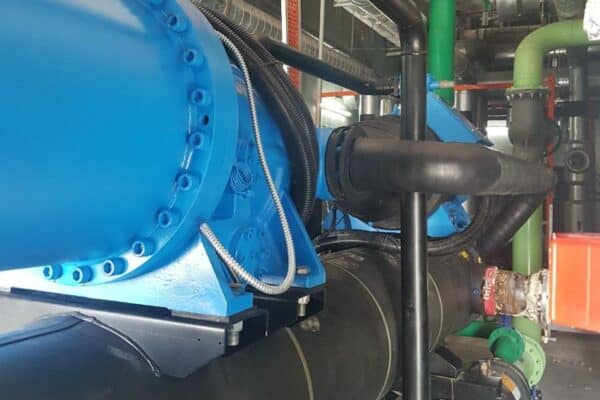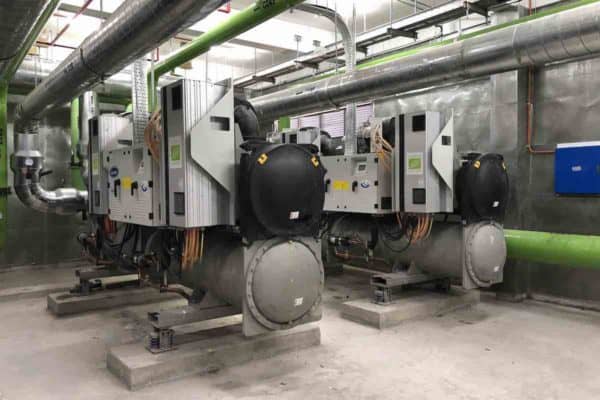What is Chiller Lift?
When it comes to improving chiller efficiency, the term chiller lift keeps repeating. Chiller lift does affect chiller efficiency. So, what exactly is chiller lift? How does it affect chiller efficiency?
Chiller lift is the difference between the refrigerant evaporating and condensing pressure. Since pressure is directly proportional to temperature, the difference between the chilled water and condenser water temperature can also be used to refer to chiller lift.
Chiller lift is sometimes known as chiller lift pressure or refrigerant temperature lift. Generally, the term “lift” refers to the difference in pressure or temperature between the water or refrigerant in the evaporator and condenser.
However, do not mistake chiller lift with chiller approach. See my post What is Chiller Approach? to understand more about chiller approach.
Reducing chiller lift can improve chiller efficiency. There are a few ways to reduce chiller lift but some may not be applicable due to certain factors.
How to Calculate Chiller Lift?
Normally, the chilled water supply temperature is around 6.7°C (44°F). With an evaporator approach temperature of below 1°C (1.8°F), the refrigerant evaporating temperature can be around 6.1°C (43°F).
Meanwhile, the standard condenser water return temperature is around 35°C (95°F). With a condenser approach temperature of below 4°C (7.2°F), the refrigerant condensing temperature can be around 38.3°C (101°F)
Now, at a temperature of 6.1°C (43°F) and 38.3°C (101°F), the pressure of the R134a refrigerant is 38 psi (evaporating) and 126.3 psi (condensing) respectively.
To calculate chiller lift, minus the refrigerant condensing pressure with the refrigerant evaporating pressure. Hence, the normal chiller lift pressure is 126.3 psi – 38 psi = 88.3 psi.
Meanwhile, the refrigerant temperature lift is 38.3°C (101°F) – 6.1°C (43°F) = 32.2°C (58°F).
In terms of the water temperature, chiller lift can be calculated by subtracting the condenser water return temperature (CWR) by the chilled water supply temperature (CHWS).
For example, if the condenser water return temperature (CWR) is 35°C (95°F) and the evaporator leaving water temperature (CHWS) is 6.7°C (44°F), the chiller lift temperature is 28.3°C (51°F).
On a side note, if you want to quickly learn about chilled water system, you can get my Chilled Water System (eBook). If you’re into design, you can enroll in my Chilled Water System Design Course where I teach you various design procedures with tons of examples.
Chilled Water System Design Course
Learn how to design a chilled water system with AHU/FCU selection, chiller sizing, cooling tower sizing, pump sizing, piping design, ductwork design and more.
How Chiller Lift Can Be Reduced?
As mentioned earlier, the lower the chiller lift, the better the chiller efficiency. But, how chiller lift affects chiller efficiency? To explain that, we must first understand how chiller lift can be reduced.
Chiller lift can be reduced by either increasing the chilled water supply temperature or reducing the condenser water return temperature. However, both methods have their own pros and cons.
Increasing the Chilled Water Supply Temperature
By increasing the chilled water supply temperature, the refrigerant evaporating temperature can be increased. Since pressure is directly proportional to temperature, the refrigerant evaporating pressure can also be increased.
Assuming that the condenser water return temperature is constant and thus, the refrigerant condensing pressure is also constant, increasing the refrigerant evaporating pressure will reduce chiller lift.
For instance, when the chilled water supply temperature is increased to 10°C (50°F), the refrigerant evaporating temperature is around 9.4°C (49°F) with an evaporator approach temperature of below 1°C (1.8°F).
At a temperature of 9.4°C (49°F), the evaporating pressure of the R134a refrigerant is 44.3 psi. Meanwhile, the condensing pressure of the R134a refrigerant is 126.3 psi.
Therefore, the new chiller lift pressure is 126.3 psi – 44.3 psi = 82 psi which is 6.3 psi less than the normal chiller lift pressure.
Reducing the Condenser Water Return Temperature
Reducing the condenser water return temperature can also reduce chiller lift. The lower the condenser water return temperature, the lower the refrigerant condensing temperature and therefore, the lower the refrigerant condensing pressure.
For example, when the condenser water return temperature is decreased to 15°C (59°F), with a delta T of around 5°C (10°F), the condenser water supply temperature is around 20°C (68°F).
When the condenser water supply temperature is around 20°C (68°F), the refrigerant condensing temperature is around 23.3°C (74°F) with a condenser approach temperature of below 4°C (7.2°F).
At a temperature of 23.3°C (74°F), the pressure of the R134a refrigerant is 77.1 psi. Meanwhile, the evaporating pressure of the R134a refrigerant is 38 psi, assuming that the chilled water supply temperature does not change yet.
Hence, the new chiller lift pressure is 77.1 psi – 38 psi = 39.1 psi which is 49.2 psi less than the normal chiller lift pressure.
As you can see, reducing the condenser water return temperature can better reduce chiller lift which is why most people are going for this method in an effort to improve chiller efficiency.
How Chiller Lift Affects Chiller Efficiency?
Now, back to the previous question, how chiller lift affects chiller efficiency? To understand, we need to bring up the PH diagram as follow:

Remember that by increasing the chilled water supply temperature, the chiller lift can be reduced. As explained earlier, increasing the chilled water supply temperature also increases the refrigerant evaporating pressure.
From the above PH diagram, we can see that when the refrigerant evaporating pressure is increased from P1 to P2′ (red line), RE2 becomes longer and HC2 becomes shorter.
RE or refrigerant effect represents cooling capacity and HC represents power consumption.
Longer RE means higher cooling capacity and short HC means lower power consumption.
Since COP equals RE divided by HC, increasing the chilled water supply temperature thereby increasing the refrigerant evaporating pressure will improve chiller efficiency.
On the other hand, let’s take a look at the PH diagram when the condenser water return temperature is reduced as follow:

As you can see, the same thing is happening when we decrease the refrigerant condensing pressure which is the result of decreasing condenser water return temperature.
Again, COP equals RE divided by HC. So, decreasing the condenser water temperature thereby decreasing the refrigerant condensing pressure will improve chiller efficiency.
I covered the relationship between chilled water temperature and chiller performance extensively in my post How Chilled Water Temperature Affects Chiller Performance?. I strongly suggest you check it out after this.
Chiller Lift Reduction Limitation
Although reducing chiller lift is good for chiller efficiency, there are reasons why many chillers are not able to operate at a low chiller lift condition.
- High Humidity Issue – Increasing the chilled water supply temperature indeed improve chiller efficiency. However, it also lead to all sorts of high humidity issues like mold and fungus growth.
- Geographical Location – Humid countries like Malaysia and Singapore have an average wet bulb temperature of around 27.8°C (82°F). Hence, there are not much room for the condenser water return temperature to reduce.
- Chiller Limitation – Conventional centrifugal and screw chillers can’t operate at too low of a condenser water return temperature. Fortunately, new magnetic bearing oil-free chillers can operate with the condenser water as low temperature as 7°C (44.6°F).
Final Thought
Every chiller has an acceptable range of lift pressure. If you are thinking of optimizing chiller efficiency by reducing the condenser water return temperature, make sure to check the limitation with the chiller manufacturer to prevent tripping your chiller. Read about Chiller Surge: Symptoms, Causes & Preventions.
Once again, you can get my Chilled Water System (eBook) to quickly learn more about chilled water system. But, if you want to learn how to design a chilled water system from start to end, I encourage you check out my Chilled Water System Design Course.
Chilled Water System Design Course
Learn how to design a chilled water system with AHU/FCU selection, chiller sizing, cooling tower sizing, pump sizing, piping design, ductwork design and more.
If you have anything to add (or ask) about this topic, leave a comment down below!


